Understanding the intricate details of household waste management systems, particularly aerated septic tanks, requires delving into the intersection of science, the environment, and engineering.
The utilization of aerated septic tanks has revolutionized wastewater management, providing an efficient, environmentally friendly solution that aligns with modern living conditions.
This essay illuminates the essential components, the science behind their operation, their impact on the environment, and the most recent advances in the field.
It also contrasts aerated septic tanks with traditional ones, offering a comprehensive view of how these systems compare, highlighting the notable differences, as well as their respective advantages and drawbacks.
Aerated septic tanks are wastewater treatment systems that use oxygen to break down organic matter more efficiently. They promote the growth of beneficial bacteria, which accelerate the decomposition process. These tanks reduce odors and help produce cleaner effluent. They are a sustainable and eco-friendly option for sewage treatment.
Basics of Aerated Septic Tanks
| Aspect | Conventional Septic Tank | Aerated Septic Tank |
|---|---|---|
| Aeration Process | Anaerobic (No oxygen) | Aerobic (With oxygen) |
| Oxygen Requirement | No oxygen supply | Requires oxygenation |
| Treatment Efficiency | Moderate | High |
| Odor Generation | Possible odors | Minimal to no odors |
| Sludge Buildup | Accumulates over time | Reduced sludge buildup |
| Maintenance | Less frequent | More frequent |
| Installation | Easier installation | Requires electrical setup |
| Effluent Quality | Lower treatment quality | Higher treatment quality |
| System Size | Typically larger | Smaller footprint |
| Cost | Lower upfront cost | Higher upfront cost |
The Primary Components of an Aerated Septic Tank: Functionality and Operations
An aerated septic tank represents a crucial advancement in our ongoing efforts to develop sustainable, dependable, and efficient waste management systems.
These tanks demonstrate the utilization of natural biological processes within a controlled environment to break down and neutralize wastewater.
They utilize air, specifically the oxygen in the air, for this process, from which the term ‘aerated’ is derived.
Hence, a comprehensive examination of its primary components is vital to comprehend their functionality and operations.
At the core of the aerated septic tank system is the Aerobic Treatment Unit (ATU). Consisting of three primary sections: the trash tank, aeration chamber, and the clarifying section, the ATU facilitates the central biological operation of the system.
Initially, wastewater flows to the trash tank, primarily functioning as a pre-treatment stage.
It captures larger particles in the wastewater that are not easily biodegradable. This is essential to prevent subsequent processing systems from clogging or disruptions.
The pre-treated waste moves into the aeration chamber, the focal point of the entire system. It is the actual residence of the aerobic bacteria that decompose the organic compounds in the waste.
The key feature of this chamber is the aeration mechanism, usually an aerator or an air diffuser, introducing oxygen into the wastewater. The resulting mixture creates a thriving habitat for aerobic bacteria.
These microscopic organisms undergo robust growth and actively break down the organic matter in the waste into simpler compounds.
By using oxygen in their metabolic process, these bacteria convert much of the waste into carbon dioxide, water, and other harmless substances, significantly reducing harmful contaminants in the wastewater.
Subsequently, the partially treated wastewater exits the aeration chamber and enters the clarifying section.
Here, through natural sedimentation processes, the remaining undecomposed solids settle at the bottom, forming a layer of ‘sludge’.
An effluent filter separates the clean, treated water from the surface, directing it to the dispersal field. The settled sludge is periodically pumped back to the aeration chamber for another treatment cycle.
The aerated septic tank system vividly showcases how we can harness the inherent power of natural biological processes for vital services such as wastewater treatment.
Moreover, it enables us to minimize our environmental impact while ensuring the efficiency and reliability of wastewater management systems, keeping us aligned with the delicate balance of our ecosystem.
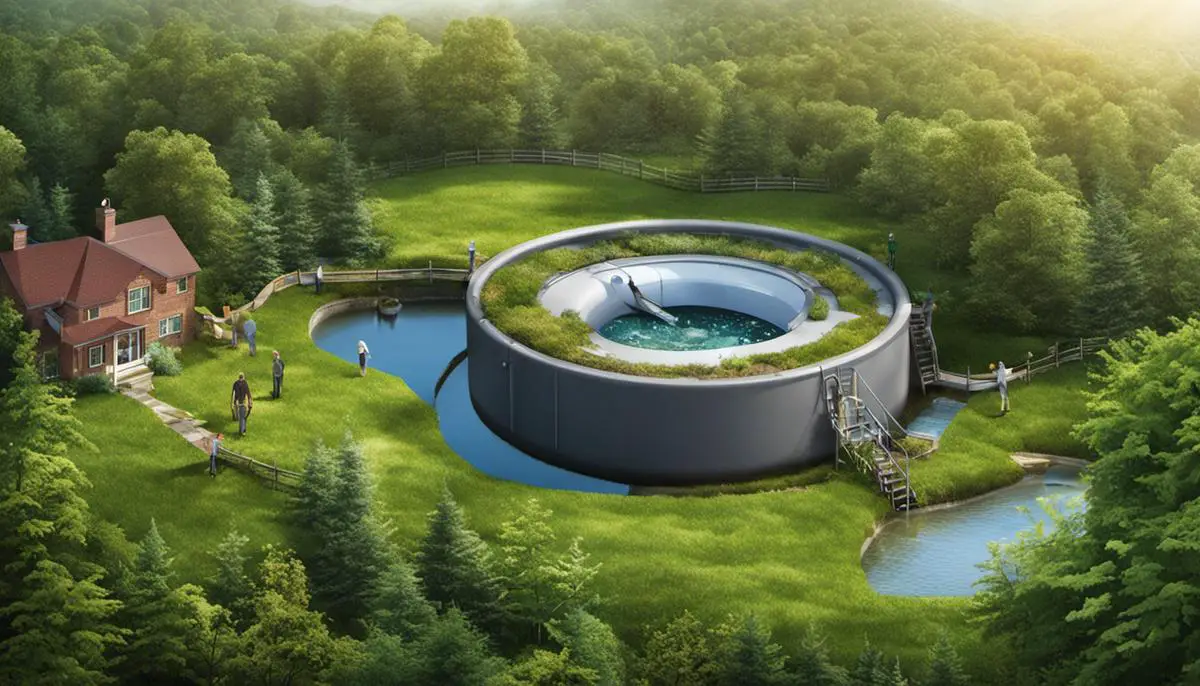
Science Behind Aerated Septic Tanks
In order to truly appreciate the function of an aerated septic tank, the scientific principles that underlie its operation must be understood.
These principles, derived from biology, physics, and chemistry, interplay in an intricate manner to enable the effective treatment of wastewater, thereby fostering sustainable waste management.
A cardinal biological principle involved in the operation of an aerated septic tank is the existence of aerobic bacterial species capable of metabolizing organic waste products in the presence of oxygen.
These bacterial mechanisms engage in a remarkable metabolic process that serves the dual function of decomposing organic matter and reducing the number of harmful contaminants in the wastewater, a process generally referred to as aerobic digestion.
Moreover, the physics of fluid dynamics play a vital role in the operation of aerated septic tanks, particularly regarding the circulation of wastewater within the tanks, and its ultimate extraction.
After water flows from the aeration chamber, it recedes to a more tranquil state in the clarifying section of the system, allowing for the gravitational settling of residual particulates – a phenomenon described by the principle of sedimentation.
The clean, treated water is then carefully detracted through an effluent filter, ensuring only the least contaminated water is released.
Finally, the principles of basic chemistry are integral to the aeration process. Oxygen introduced during aeration reacts with the organic waste within wastewater, propelling a series of oxidization reactions that lead to the breakdown of complex organic molecules into simpler waste forms, which are more easily consumed by aerobic bacteria.
While these principles may seem complex, the process peaceably mimics the natural biological methods of cleansing our rivers and oceans.
As such, aerated septic tanks ingeniously leverage these principles for sustainable waste management, reducing the pollution of our natural waters and lowering our environmental footprint.
In totality, the operation of aerated septic tanks is a brilliant exhibition of the harmonized application of biology, physics, and chemistry. It is a testament to the potential for scientific innovation in promoting both ecosystem health and human well-being.
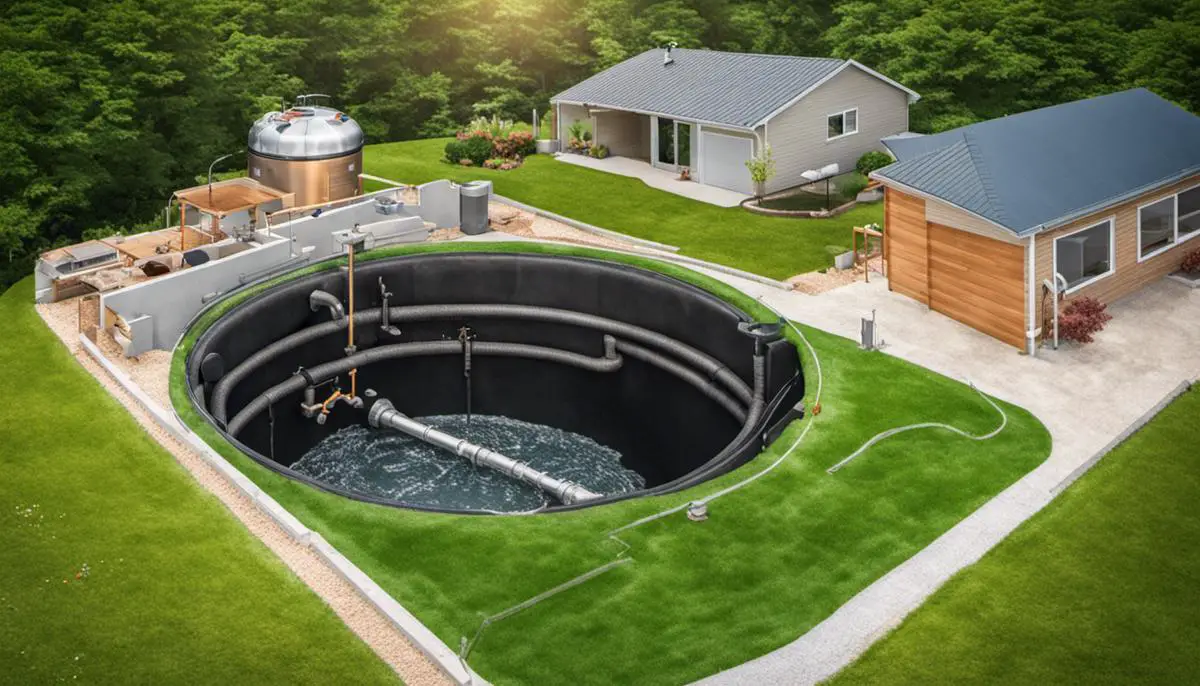
Aerated Septic Tanks vs Traditional Septic Tanks
Delving into Traditional Septic Tanks and Their Functional Integrity
Contrary to aerated septic tanks that operate on the principles of aerobic degradation, traditional septic systems utilize an anaerobic process – a biological process that takes place in the absence of oxygen.
Traditional septic systems primarily comprise of a septic tank and a drain field. The input into the system is the household wastewater, also referred to as sewage.
The process begins with the segregation of solid waste from the wastewater in the septic tank, where anaerobic bacteria work to decompose these solids into sludge.
Time plays an integral role in these conventional units as the solid waste utilizes several weeks to completely break down.
Contrastingly, the aeration process in ATUs is markedly faster, owing to the enhanced metabolic ability of aerobic bacteria when compared to their anaerobic counterparts.
The categorization of contaminants in a traditional septic system is also distinctly defined, with solids being compartmentalized in distinct zones, according to their density and ability to decompose.
The top layer or zone contains fats, oils, and grease and is generally less dense. The bottom layer constitutes heavier sediments that overtime accumulate as sludge.
The drain field in a traditional septic tank plays an essential role in the purification process of the wastewater.
Following initial organic matter decomposition in the septic tank, the semi-cleaned water is moved to the drain field where it further undergoes filtration and treatment in the soil.
The soil’s natural microbial life furthers the degradation process of any remaining organic material, pathogenic organisms, and some nutrients.
Although conventional septic tanks have been the norm in wastewater treatment historically, they do bear disadvantages.
For one, the degradation of waste in the absence of oxygen produces methane gas – a potent greenhouse gas. Furthermore, maintenance is key to the longevity and effectiveness of traditional septic tanks. Inadequate maintenance can cause the solids to accumulate and block the drain field, leading to system malfunction.
Aerated septic tanks and traditional septic tanks both rely heavily on the role of bacteria to break down waste.
However, the core point of divergence lies in the introduction of oxygen to enhance the speed and efficiency of the process.
Traditional septic tanks that operate on anaerobic processes tend to be less efficient in pollutant reduction and require more substantial use of space for drain fields.
In contrast, the aerobic operation in aerated septic tanks improves waste breakdown efficiency, reduces size and can be a more environmentally viable choice for sustainable wastewater management.
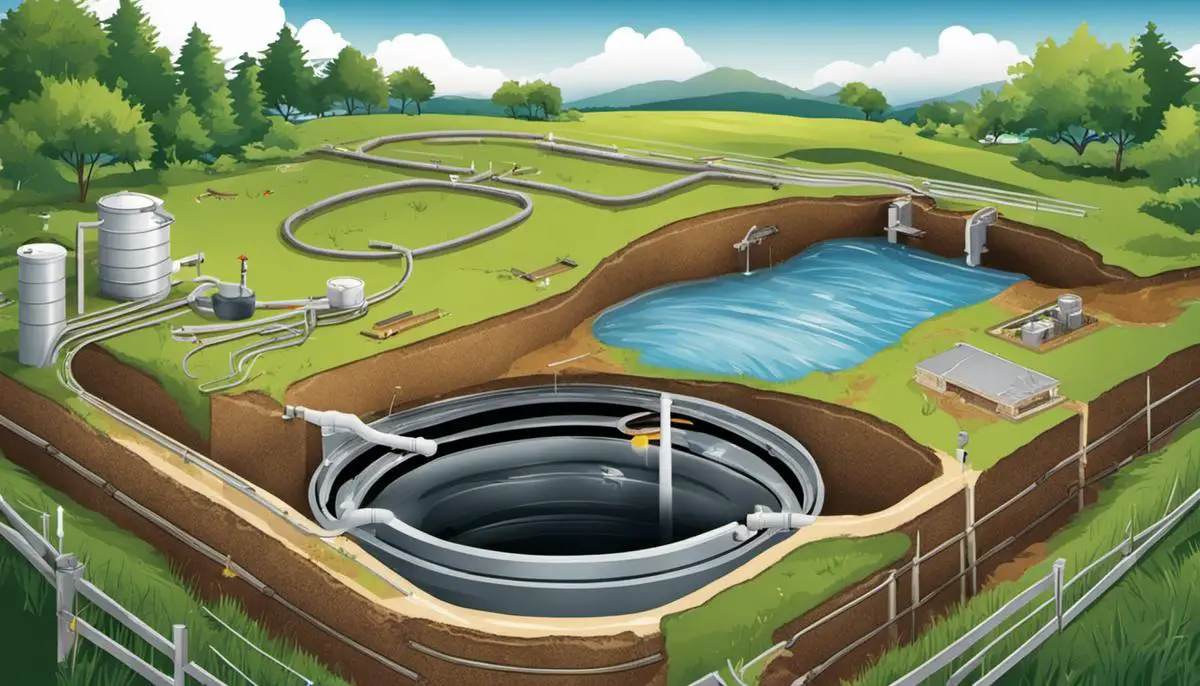
Impact and Benefits of Aerated Septic Tanks
Environmental Implications of Aerated Septic Tanks: Enhancing Ecosystem Health
This portion of the discourse illuminates the profound ecological implications and benefits that accompany the application of aerated septic tanks in wastewater management.
Conventionally, the effectiveness of a septic system is viewed in the context of its efficiency in waste breakdown and the quality of treated waste.
However, the context should also be expanded to include the septic system’s impact on the environment, particularly in terms of its potential for aiding or hampering ecological health.
Aerated septic tanks, with their reliance on rigorous natural mechanisms for waste decomposition, contribute significantly to the mitigation of several environmental issues, leading to enhanced ecosystem health.
These benefits cannot be disregarded in a world that’s grappling with unprecedented environmental crises, primarily pollution, and decline in biodiversity.
Chiefly, aerated septic tanks substantially contribute to the reduction of pollution levels by effectively decreasing the amount of harmful pollutants entering the environment. The robust bacterial action, under oxygenated conditions, is proficient in breaking down harmful substances in wastewater.
The consequent effluent, therefore, contains significantly reduced levels of pollutants as compared to those released by conventional septic systems. The oxygen-infused environment in the aeration chamber can degrade not just solid wastes but also stubborn compounds, ultimately restricting their entry into the ecosphere.
Similarly, this cleaner effluent disposes a reduced amount of excess nutrients, notably nitrogen and phosphorus, into the environment.
Excessive nutrient levels in water bodies spur eutrophication, a process responsible for algal blooms and subsequent depletion of dissolved oxygen in the water.
By maintaining nutrient levels within relative balance, aerated septic tanks effectively inhibit the advent of such destructive phenomena, aiding in the preservation of aquatic biodiversity.
Moreover, aerated septic tanks play an instrumental role in conserving local soil health. The ATUs’ efficacy in treating wastewater ensures that the surrounding soil doesn’t undergo persistent nutrient imbalance or toxicity due to leaching of improperly treated wastewater.
Resultantly, they maintain soil fertility, support the growth of local vegetation, and prevent soil erosion.
It’s also worth noting that aerated septic tanks substantially curtail greenhouse gas (GHG) emissions vis-a-vis traditional septic tanks.
Anaerobic decomposition in conventional septic tanks generates substantial amounts of methane, a potent greenhouse gas. In stark contrast, aerated septic tanks favor aerobic decomposition, which predominantly results in carbon dioxide, a substantially less harmful GHG.
Indubitably, the application of aerated septic tanks can carve a pathway for sustainable functioning within residential and commercial units, encapsulating a well-rounded environmentally-conscious approach to waste management.
Through a systems perspective, it’s evident that such intervention not only addresses the challenge at hand – effective waste treatment, but also cascades benefits into larger domains such as pollution control, biodiversity conservation, and climate action.
As scholars at the forefront of scientific knowledge and its societal implications, it is incumbent to recognize the potential of these system-based solutions and continue to foster innovative practices that harmonize human and ecological health.

Latest Research and Advances
Recent scientific advances and research in the field of aerated septic tanks have primarily revolved around enhancing efficiency, improving reliability, and minimizing ecological impact.
As a testament to the convergence of environmental science, microbiology, and engineering, these developments have shaped the wastewater treatment paradigm, featuring new methods, technologies, and practices for employing aerobic biological processes in waste management.
Advancements in sensor technologies have significantly improved tank management and maintenance. Innovative sensor systems now allow for real-time monitoring of key variables like pH, temperature, and oxygen levels in the ATU.
This technology not only ensures optimal performance and early detection of potential issues but also reduces the frequency of physical inspection, thereby promoting safety and operational efficiency.
Furthermore, research efforts have led to the isolation and utilization of novel aerobic bacterial strains capable of degrading persistent organic pollutants (POPs).
These microbial strains, capitalizing on their specific enzymatic machineries, can break down resilient chemical compounds like pharmaceuticals and personal care products, which traditionally escape conventional treatment processes.
Simultaneously, advancements in biotechnology have made it possible to engineer these bacteria for enhanced degradative capacity and survival in fluctuating environmental conditions.
Technological advancements also extend to the aeration systems.
The optimization of diffuser design, for instance, ensures efficient oxygen transfer while minimizing energy consumption. Low-energy, air-lift systems have emerged as a sustainable option, replacing mechanical aerators and reducing the carbon footprint of the operation.
Meanwhile, the incorporation of solar power further enhances the sustainability of the system, aligning it with renewable energy goals.
Additionally, studies exploring biofilm technology have shown promise in augmenting the biological treatment process. Biofilms, consisting of microorganism communities, provide a safeguard against adverse operational conditions, enhancing resiliency, and maintaining treatment efficiency.
They also function as a self-regenerating biological catalyst, thereby reducing the need for chemical additives.
Scientific exploration into post-treatment processes, like constructed wetlands, has additionally offered further paths to the removal of remaining contaminants, such as nitrogen, that could potentially harm aquatic ecosystems.
These green infrastructures serve to polish the effluent, achieving exceptional levels of treatment, and creating synergistic outcomes for both human societies and ecological systems.
While seemingly sophisticated, these measures intertwine a deep scientific understanding with practical application, embodying the essence of an aerated septic system.
It is a testament to humanity’s ability to mimic and take advantage of natural processes to better our societies and minimize our environmental footprint.
As we continue delving deeper into this intriguing world of microbes and mechanisms, the complexity unwinds, serving as an inspiration and reminding us of our connections to, and dependence on, the intricacies of nature.
These continuing advancements represent a multi-faceted approach to wastewater management, showing the unlimited potential inherent in combining biological solutions, innovative technology, and sustainable energy usage.
Underlying the meticulous craftsmanship of the aerated septic tanks are principles of environmental stewardship and sustainability.
Quite clearly, our pursuit of knowledge, innovation, and a sustainable future is very well reflected in the science and application of aerated septic tanks.
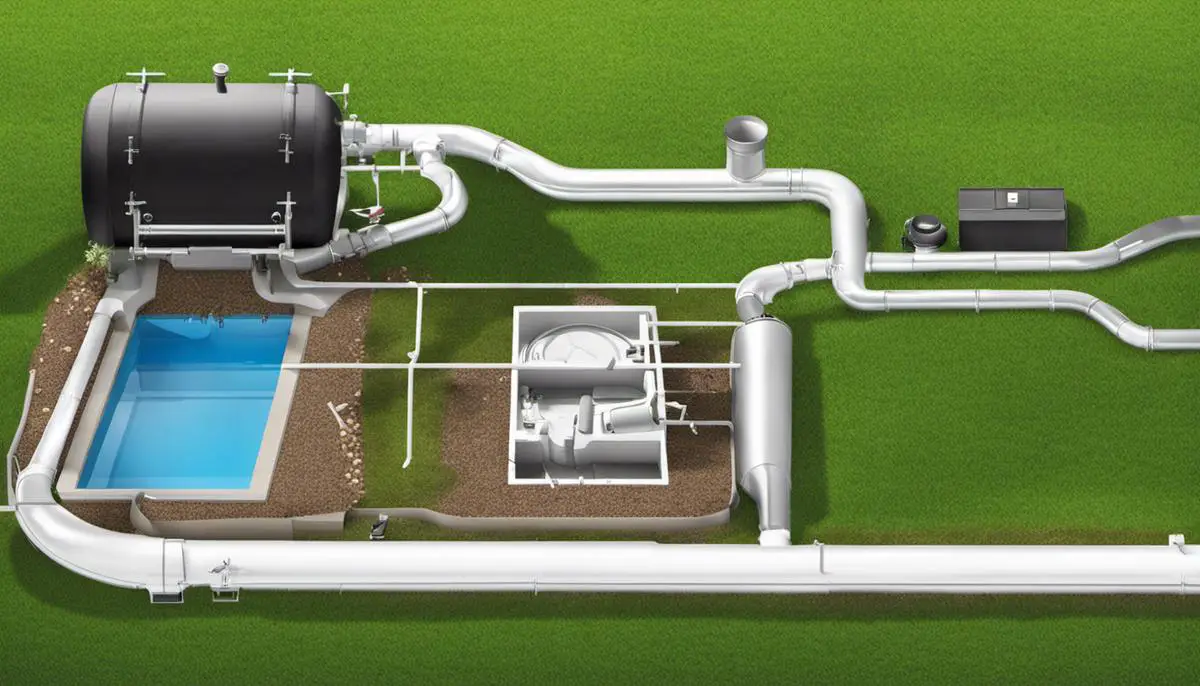
Fundamentally, aerated septic tanks underscore a critical rebalancing act between human needs for hygiene and sanitation and the environmental imperatives that inform sustainable living.
The striking potency of these systems in enhancing waste breakdown, minimizing pollution, and attenuating the maintenance workload underscores their increasing adoption worldwide.
Delving through their core design to the most recent research and technological advances, we further illuminate the continuing evolution and importance of these systems.
Despite the complexity of the science behind these systems and the technicalities involved in their operation, a comprehensive understanding is paramount to making informed choices in our quest for environmental sustainability and more efficient waste management.
[faq-schema id=”16698″]




![How to Remove Crystallized Urine [Explained]](https://homepander.com/wp-content/uploads/2022/02/How-To-Remove-Crystallized-Urine.jpg)





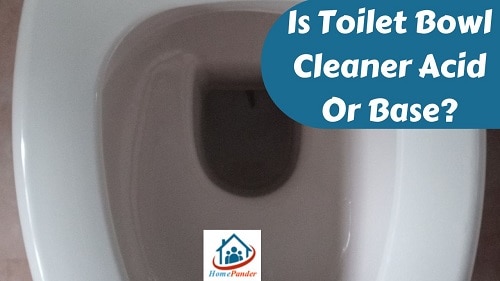
![How To Clean Dark Grout That Has Turned White [5 Easy Ways]](https://homepander.com/wp-content/uploads/2021/12/How-To-Clean-Dark-Grout-That-Has-Turned-White.webp)